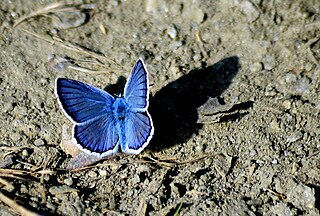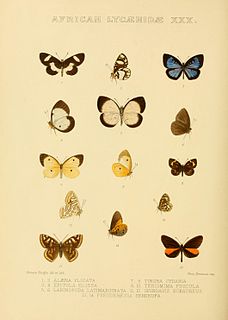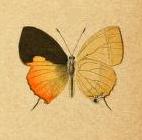
The superfamily Papilionoidea contains all the butterflies except for the moth-like Hedyloidea.

Riodinidae is the family of metalmark butterflies. The common name "metalmarks" refers to the small metallic-looking spots commonly found on their wings. There are 1532 species and 146 genera of metalmark butterflies in the world. Although mostly neotropical in distribution, the family is represented both in the Nearctic and the Palearctic.

The Nymphalinae are a subfamily of brush-footed butterflies. Sometimes, the subfamilies Limenitidinae, and Biblidinae are included here as subordinate tribe(s), while the tribe Melitaeini is occasionally regarded as a distinct subfamily.

Lycaeninae, the coppers, are a subfamily of the gossamer-winged butterflies (Lycaenidae).

Miletinae is a subfamily of the family Lycaenidae of butterflies, commonly called harvesters and woolly legs, and virtually unique among butterflies in having predatory larvae. Miletinae are entirely aphytophagous. The ecology of the Miletinae is little understood, but adults and larvae live in association with ants, and most known species feed on Hemiptera, though some, like Liphyra, feed on the ants themselves. The butterflies, ants, and hemipterans, in some cases, seem to have complex symbiotic relationships benefiting all.

Polyommatinae, the blues, are a subfamily of gossamer-winged butterflies (Lycaenidae). It was long used to assign taxa of unclear relationships, and its contents are in need of revision. Several genera might not even belong here.

The Aphnaeini are a tribe of butterflies in the family Lycaenidae.

Zizeeria knysna, the dark grass blue or African grass blue, is a species of blue butterfly (Lycaenidae) found in Africa, on Cyprus and the Iberian Peninsula.

Anthene amarah, the black-striped hairtail, leaden hairtail or leaden ciliate blue, is a butterfly of the family Lycaenidae. It is found in tropical Africa and Arabia. The habitat consists of savanna and occasionally open areas in the forest zone.

Pseudaletis antimachus is a butterfly in the family Lycaenidae. It is found in Sierra Leone, Nigeria, Cameroon, Gabon, the Republic of the Congo, the Central African Republic, the Democratic Republic of the Congo, Uganda and Tanzania.

Cigaritis nilus, the Saharan silverline, is a butterfly in the family Lycaenidae. It is found in Senegal, the Gambia, Guinea, Mali, Burkina Faso, Ghana, northern and eastern Nigeria, Niger, Chad, Cameroon, southern Sudan, Uganda and northern Kenya. The habitat consists of sub-deserts and deserts, the Sahel, Sudan savanna and Guinea savanna.

Tarucus rosacea, the Mediterranean Pierrot or Mediterranean tiger blue, is a butterfly in the family Lycaenidae. It is found in Mauritania, Senegal, the Gambia, Guinea, Burkina Faso, northern Ivory Coast, northern Ghana, northern Nigeria, Niger, northern Cameroon, Chad, Sudan, Ethiopia, northern Uganda, north-western Kenya, Somalia, Djibouti and Arabia. The habitat consists of Sudan savanna and the Sahel.

Azanus isis, the white-banded babul blue, is a butterfly in the family Lycaenidae. It is found in Senegal, Guinea-Bissau, Guinea, Sierra Leone, Liberia, Ivory Coast, Ghana, Togo, southern Nigeria, Cameroon, the Republic of the Congo, Angola, the Democratic Republic of the Congo, Uganda, Ethiopia, north-western Tanzania and northern Zambia. The habitat consists of forest edges and clearings, woodland and moist savanna.
Chilades eleusis, the sky-blue Cupid, is a butterfly in the family Lycaenidae. It is found in Senegal, the Gambia, Guinea-Bissau, Burkina Faso, northern Ghana, northern Nigeria, Niger, northern Cameroon, Chad, Sudan and Egypt. The habitat consists of dry habitats, Sudanian Savanna and the Sahel.

Lepidochrysops parsimon, the western giant Cupid, is a butterfly in the family Lycaenidae. It is found in Guinea, Sierra Leone, southern Burkina Faso, Ivory Coast, Ghana, Togo, western Nigeria, Cameroon and the Central African Republic. The habitat consists of the forest/savanna transition zone.
Anthene irumu, the Irumu ciliate blue, is a butterfly in the family Lycaenidae. It is found in Guinea, Sierra Leone, Ivory Coast, Ghana, Togo, Nigeria, Cameroon, the Republic of the Congo, the Central African Republic, the Democratic Republic of the Congo, Uganda, north-western Tanzania, Zambia and Zimbabwe. The habitat consists of drier forests and open areas in the main forest zone, as well as Guinea savanna.

Anthene juba, the anomalous ciliate blue, is a butterfly in the family Lycaenidae. It is found in Guinea, Sierra Leone, Liberia, Ivory Coast, Ghana, eastern Nigeria and western Cameroon. The habitat consists of primary forests.

Anthene lyzanius, the black-patches, is a butterfly in the family Lycaenidae. It is found in Sierra Leone, Liberia, Ivory Coast, Ghana, Nigeria, Cameroon, Gabon, the Republic of the Congo and northern Angola.
















